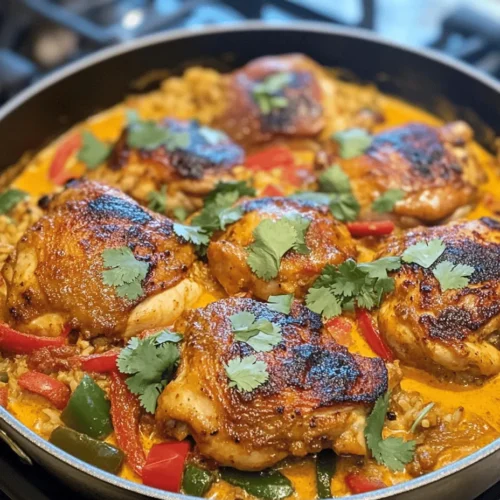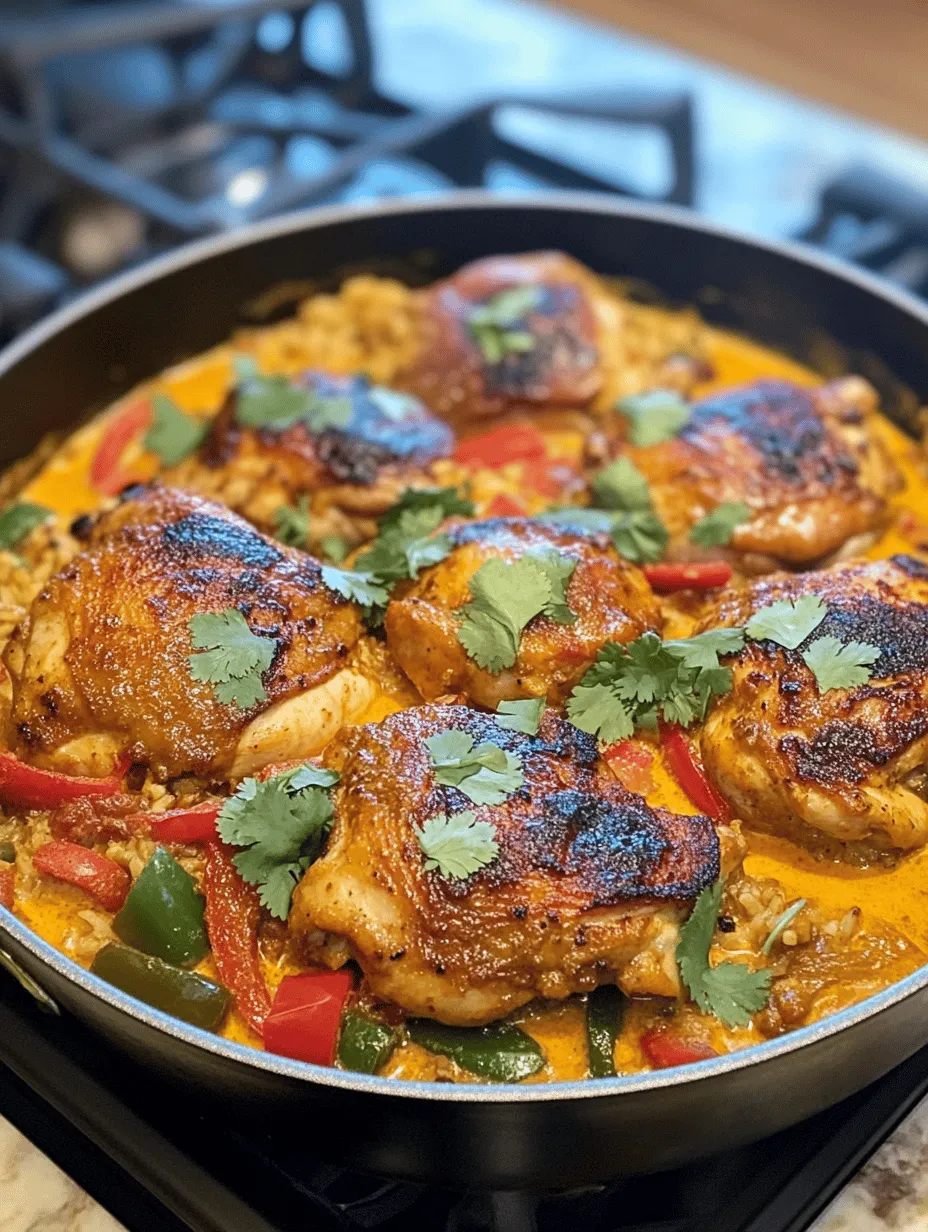Introduction
Brazilian cuisine is a vibrant tapestry woven from the country’s rich cultural heritage and diverse ingredients. With influences from Indigenous, African, and Portuguese culinary traditions, Brazilian dishes are known for their bold flavors, colorful presentations, and an array of spices that tantalize the taste buds. One dish that stands out in this culinary landscape is the Spicy Brazilian Coconut Chicken—a delightful fusion of spices and creamy coconut that brings the essence of Brazil right to your kitchen.
Spicy Brazilian Coconut Chicken is a dish that embodies the spirit of Brazilian cooking. It features tender, juicy chicken thighs marinated in a medley of spices, simmered in a luscious coconut milk sauce that balances heat with creaminess. The vibrant colors of fresh vegetables and the aromatic spices create a visual feast, making it not only delicious but also a stunning centerpiece for any meal. Whether you’re hosting a dinner party or simply looking to spice up your weeknight dinner, this dish promises to deliver an unforgettable dining experience.
Understanding the Ingredients
To truly appreciate the Spicy Brazilian Coconut Chicken, it’s essential to understand the key ingredients that contribute to its unique flavor profile. Each component plays a crucial role in creating the dish’s signature taste, and selecting high-quality, fresh ingredients is paramount for achieving the best results.
Boneless, Skinless Chicken Thighs
The foundation of this dish is boneless, skinless chicken thighs, which are favored for their rich flavor and moist texture. Unlike chicken breasts, which can become dry when cooked, thighs remain juicy even when subjected to high heat. Their slightly higher fat content enhances the overall flavor of the dish, allowing them to absorb the marinade’s spices beautifully. When selecting chicken thighs, look for those that are fresh and organic if possible, as they will provide the best flavor and quality.
Coconut Milk
Coconut milk is the star of this dish, serving as the creamy base that enriches the sauce. It not only adds a subtle sweetness but also balances the heat from the spices. In Brazilian cuisine, coconut milk is frequently used, particularly in dishes from regions like Bahia, where the tropical climate makes coconuts readily available. When choosing coconut milk, opt for a full-fat version for the creamiest texture and richest flavor.
Red Curry Paste
Red curry paste is another critical component of the Spicy Brazilian Coconut Chicken. This vibrant paste is a blend of aromatic spices, such as red chili peppers, garlic, ginger, lemongrass, and galangal, creating a robust flavor profile. The heat level of red curry paste can vary, so it’s important to taste and adjust according to your personal spice preference. In this recipe, the curry paste not only adds heat but also depth, infusing the chicken and coconut milk with complex flavors that dance on the palate.
Fresh Vegetables
Colorful fresh vegetables play an essential role in enhancing both the flavor and visual appeal of the dish. Bell peppers, for instance, add a sweet crunch that contrasts beautifully with the creamy sauce. Onions, garlic, and ginger are also key aromatics that lay the foundation for the dish’s flavor. When choosing vegetables, look for the freshest options available, as their quality will significantly impact the overall taste of the meal.
Lime Juice and Brown Sugar
To achieve a well-rounded flavor profile, lime juice and brown sugar are added to the dish. Lime juice introduces a zesty brightness that cuts through the richness of the coconut milk, while brown sugar adds a hint of caramel sweetness. This balance of sweet, spicy, and tangy elements is crucial in Brazilian cooking, where contrasting flavors often harmonize to create memorable dishes.
Importance of Freshness and Quality in Ingredient Selection
The success of the Spicy Brazilian Coconut Chicken hinges on the freshness and quality of its ingredients. Fresh produce not only enhances flavor but also contributes to the dish’s nutritional value. When possible, visit local markets or specialty grocery stores to find high-quality chicken, aromatic spices, and seasonal vegetables. The effort invested in selecting the best ingredients will result in a more delicious and satisfying meal.
Marinating the Chicken
Marinating the chicken is a vital step in developing the dish’s robust flavor. The marinade allows the meat to absorb the spices and coconut milk, ensuring that each bite is bursting with flavor. Proper marination also helps to tenderize the chicken, resulting in a succulent texture.
Importance of Marination in Developing Flavor
The process of marination serves several purposes: it infuses the chicken with flavor, tenderizes the meat, and enhances the overall juiciness of the dish. The longer the chicken marinates, the more pronounced the flavors become. This is particularly important when working with bold spices like red curry paste, as the chicken needs time to soak up those rich, complex flavors.
Step-by-Step Guide on How to Properly Marinate the Chicken
1. Prepare the Marinade: In a bowl, combine the red curry paste, coconut milk, lime juice, and a pinch of salt. Stir until well mixed to create a smooth marinade.
2. Add the Chicken: Place the boneless, skinless chicken thighs in a large resealable bag or a shallow dish. Pour the marinade over the chicken, ensuring that each piece is well coated.
3. Seal and Refrigerate: Seal the bag or cover the dish with plastic wrap. Refrigerate for at least 30 minutes, although marinating for 2-4 hours is recommended for optimal flavor penetration. For best results, marinate overnight.
4. Remove from Marinade: Before cooking, remove the chicken from the marinade and let it sit at room temperature for about 15 minutes. This allows for even cooking.
Recommended Marination Time for Optimal Flavor Penetration
While a quick 30-minute marinade can provide some flavor, allowing the chicken to marinate for at least 2-4 hours is ideal. If time permits, overnight marination in the refrigerator will yield the best results, as the chicken will be thoroughly infused with the marinade’s flavors, resulting in a more aromatic and flavorful dish.
Discussing the Balance of Flavors in the Marinade: Sweet, Spicy, and Tangy
The marinade for Spicy Brazilian Coconut Chicken is a harmonious blend of sweet, spicy, and tangy elements. The red curry paste adds heat and depth, while the coconut milk and brown sugar introduce sweetness. The lime juice provides a refreshing acidity that balances the richness of the coconut milk. This interplay of flavors is characteristic of Brazilian cuisine, where contrasting tastes create a delightful culinary experience.
Sautéing Aromatics: Building Flavor
Sautéing aromatics is a crucial technique in cooking, especially in preparing the base for dishes like Spicy Brazilian Coconut Chicken. This step enhances the flavors, creating a fragrant foundation that elevates the overall dish.
Explanation of Why Sautéing Aromatics is Crucial in Cooking
When onions, garlic, and ginger are sautéed, they release their essential oils and flavors, creating a fragrant base that permeates the entire dish. This technique not only intensifies the flavor but also adds depth, making the final dish more complex and satisfying. Properly sautéed aromatics can transform a simple dish into a culinary masterpiece.
Detailed Instructions on How to Sauté Onions, Garlic, and Ginger
1. Heat the Oil: In a large skillet or pot, heat a couple of tablespoons of oil over medium heat. Choose an oil with a high smoke point, such as vegetable or coconut oil.
2. Add the Onions: Once the oil is hot, add diced onions to the pan. Sauté for 3-5 minutes until they become translucent and slightly golden.
3. Incorporate Garlic and Ginger: Add minced garlic and grated ginger to the pan. Sauté for an additional 1-2 minutes, stirring frequently to prevent burning. The mixture should become fragrant, indicating that the aromatics are ready for the next step.
4. Removing from Heat: Once the garlic and ginger are aromatic, remove the pan from heat. This sautéed mixture will serve as the flavorful backbone of your Spicy Brazilian Coconut Chicken dish.
Importance of Cooking Techniques to Enhance Flavor Profiles
The techniques used during cooking play a significant role in flavor development. Sautéing aromatics at the right temperature ensures they caramelize without burning, enhancing their natural sweetness and adding complexity to the dish. This attention to detail in the cooking process is what sets apart a good dish from a great one.
By understanding the ingredients and mastering the marinating and sautéing techniques, you are well on your way to creating a delectable Spicy Brazilian Coconut Chicken. The next steps will guide you through bringing this vibrant dish to life, ensuring that you and your guests can savor the delicious and aromatic flavors of Brazil in every bite.

Tips for Achieving the Perfect Sauté Without Burning the Ingredients
To create a delicious Spicy Brazilian Coconut Chicken, mastering the sautéing technique is essential. Here are some practical tips to ensure that your ingredients get perfectly sautéed without burning:
1. Use the Right Oil: Opt for oils with a higher smoke point, such as vegetable oil or coconut oil, to prevent burning. Avoid olive oil for this step as it has a lower smoke point.
2. Preheat the Pan: Make sure your skillet or frying pan is adequately preheated before adding the oil. A hot pan ensures a good sear on the chicken, which helps in locking in moisture.
3. Don’t Overcrowd the Pan: Place the chicken thighs in a single layer, leaving space between each piece. Overcrowding lowers the pan’s temperature, leading to steaming instead of sautéing.
4. Stay Attentive: Constantly monitor the cooking process. Stir occasionally but not too frequently, allowing each side of the chicken to develop a golden-brown crust.
5. Use Medium Heat: Start with medium heat to get a good sear without burning. If you notice smoke, reduce the heat immediately.
Cooking the Chicken: Techniques for Perfect Results
Browning the chicken is an essential step in this recipe, as it enhances the overall flavor profile and texture of the dish. Here’s how to do it effectively:
Step-by-Step Guide to Cooking Chicken Thighs Properly
1. Prepare the Chicken: After marinating your chicken thighs, remove them from the marinade and let them drain for a few moments. This prevents excess liquid from causing the chicken to steam instead of sear.
2. Heat the Oil: In a large, heavy-bottomed skillet, heat 2 tablespoons of vegetable oil over medium heat until shimmering.
3. Brown the Chicken: Carefully add the chicken thighs to the pan, skin side down (if using skin-on thighs). Cook for about 5-7 minutes without moving them. This allows the skin to crisp up nicely.
4. Flip and Cook: Once golden, flip the chicken and cook the other side for another 5-7 minutes. The chicken should be browned on both sides and cooked through.
5. Checking for Doneness: The internal temperature of the chicken should reach 165°F (74°C). You can use a meat thermometer for accuracy. Alternatively, cut into the thickest part of the chicken; the juices should run clear, not pink.
Incorporating Vegetables and Sauce
Adding vegetables to your Spicy Brazilian Coconut Chicken not only enhances the dish’s nutrition but also adds vibrant colors and flavors.
Explanation of How Adding Vegetables Elevates the Dish
Bell peppers, onions, and garlic create a beautiful medley when sautéed. They absorb the chicken’s juices and the marinade, resulting in a cohesive flavor profile that ties the dish together.
Detailed Steps on Adding Bell Peppers and the Reserved Marinade
1. Sauté the Vegetables: After browning the chicken, remove it from the pan and set it aside. In the same skillet, add sliced bell peppers (use a mix of colors for a stunning presentation) along with chopped onions and minced garlic. Sauté for about 3-4 minutes until they begin to soften.
2. Add the Marinade: Pour in the reserved marinade from the chicken. This will deglaze the pan, lifting all those lovely browned bits off the bottom.
3. Incorporate the Chicken: Return the chicken thighs to the skillet, nestling them among the vegetables. Stir gently to combine everything.
Importance of Simmering for Flavor Infusion and Cooking Vegetables
Simmering allows the flavors to meld beautifully. It also ensures that the vegetables are tender and infused with the spicy and aromatic marinade.
How to Achieve the Right Consistency of the Sauce
As the mixture simmers, the sauce will begin to thicken. If it becomes too thick, add a splash of coconut milk or water to adjust the consistency to your liking. You want a sauce that clings to the chicken and vegetables without being overly runny.
Final Steps: Simmering and Serving
Importance of Simmering for Deep Flavor Development
Once all the ingredients are combined, allow the dish to simmer on low heat for about 10-15 minutes. This step is crucial for developing deep flavors as the chicken absorbs the spices and the coconut milk melds with the marinade.
How to Know When the Dish is Ready for Serving
Check the chicken again to ensure it’s cooked through and the vegetables are tender. The sauce should be bubbling gently and have a rich, inviting aroma.
Presentation Tips: Garnishing with Fresh Cilantro
For a finishing touch, garnish your Spicy Brazilian Coconut Chicken with freshly chopped cilantro before serving. Not only does this add a pop of color, but it also enhances the dish’s fresh flavors.
Recommended Serving Suggestions: Pairing with Rice and How to Plate
This dish pairs beautifully with fluffy white rice or coconut rice, which complements the tropical flavors of the chicken. To plate, serve a generous scoop of the chicken and vegetable mix over a bed of rice, ensuring to drizzle some of the sauce on top. You can also serve lime wedges on the side for an added burst of freshness.
Cultural Significance of Brazilian Cuisine
Brazilian cuisine is a rich tapestry woven from indigenous, African, and Portuguese influences. Each of these cultures has contributed unique ingredients and cooking techniques, creating a vibrant culinary landscape.
Brief Exploration of the Influence of Indigenous, African, and Portuguese Cuisines in Brazil
Indigenous ingredients like cassava and a variety of tropical fruits reflect the country’s native heritage, while African influences bring in bold flavors and cooking methods, such as the use of spices and slow-cooking techniques. The Portuguese colonizers introduced new ingredients like rice and sugar, which have since become staples in Brazilian cuisine.
How Spicy Brazilian Coconut Chicken Reflects These Cultural Influences
Spicy Brazilian Coconut Chicken is a perfect representation of this culinary amalgamation. The use of coconut milk, a staple in many Brazilian dishes, showcases the tropical bounty of the region. The spices used in the marinade reflect the bold flavors brought by African cuisine, while the dish’s simplicity pays homage to indigenous cooking techniques.
Discussion on the Popularity of Coconut in Brazilian Dishes
Coconut is not just a flavor enhancer in Brazilian cooking; it is a cultural symbol. From coconut water to shredded coconut in desserts, this ingredient is celebrated across various Brazilian dishes, showcasing the versatility and richness of Brazilian culinary traditions.
Conclusion
Spicy Brazilian Coconut Chicken is not just a meal; it is a celebration of flavors, cultures, and cooking techniques that come together to create a dish that is both comforting and exotic. The balance of spices, the creaminess of coconut milk, and the vibrant colors of the vegetables make this dish a feast for the senses.
The techniques used in this recipe, from properly sautéing the chicken to allowing flavors to develop through simmering, ensure that every bite is packed with deliciousness. This dish brings warmth and joy to the table, perfect for family gatherings or a cozy night in.
As you explore the diverse world of Brazilian cuisine, let this recipe inspire you to try more dishes that showcase its rich heritage and flavor. Each recipe tells a story, and by diving into Brazilian cooking, you celebrate the fusion of cultures that make it so unique.



